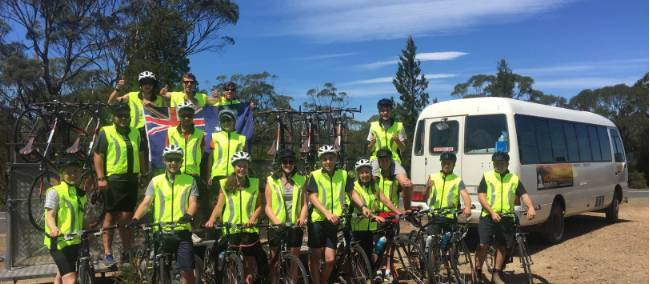
Students cycling in Tasmania | Holly Van De Beek
Blog home / Australian Educational Trips: 6 things to consider
International school trips won’t be going ahead as planned for the foreseeable future, but that’s ok because there is a plethora of diverse learning outside of the classroom experiences to be had right here in Australia.
If you’ve never planned an active or educational school trip longer than a week at home, then you may want to get ready for a few key differences. Australia provides high quality, safe experiences, but they do come with extra costs and often, regulations.
PRICE
A two-week trip in Nepal for AUD$4k with flights is very possible. Getting the same length of trip for the same price in Australia, at the same level of quality, will be harder. Internal flights are already on the higher end when compared with cheaper flights to Asia. Wages for experienced Australian guides and staff are much higher than in developing countries. As can be National Park fees and permits, accommodations and the cost of nearly everything to operate a trip, from the muesli in the morning to fuel in the tank.
It costs more to operate quality wilderness programs in Australia. Your existing budgets are likely to go a lot longer if you can reduce the length of trip.
GROUP SIZES
The Cradle Mountain Lake St Clair National Park in Tasmania only permits 10 paying walkers per group. That’s a little awkward when you have a group of 25-35 kids you want to take away.
Many of our National Parks or places worth protecting do come with some rules and regulations that you may not see abroad; however, they are in place to minimise the impact of popular places so they can be enjoyed by everyone. Before you get too excited about a destination, check the National Park commercial group size allowance.
SEASONALITY
As good as the weather is in Australia it certainly pays to choose the right season when choosing to take students into our wilderness. Many schools get the advantage of the warmer weather in the northern hemisphere with mid-year trips however that is the Aussie winter, which is ideal if you're headed out to the desert.
Here's a quick glance at the best times to visit some of our most popular places.
- Tasmania: ideal for October to March, the warmer summer months with typically less rain. It can rain and temperatures can drop at anytime during summer.
- Darwin and Kakadu: Outside the wet season, June to August is coolest with least humidity
- Alice Springs and Larapinta: May to September are the coolest months, winter nights can be freezing
- Flinders Ranges and Kangaroo Island: The winter months June to August are the coolest times, however it is also rainy season on Kangaroo Island
- Ningaloo Reef and Karijiji National Park: Between May and September, the milder, drier months. Average winter temperatures can still be warm, mid 20C.
- South West Australia: Most of the year really. Cooler to walk during winter although swimming might not be in the itinerary.
- Daintree Rainforrest and Cape Tribulation:
- New Zealand: Late September it begins to warm up for a typically mild summer before autumn brings the changing of the leaves and the lower temperatures again. It can rain and temperatures can drop at anytime during summer.
SERVICE LEARNING
Our wilderness is iconic and helping to clean and protect it is of valuable need and instils a long-standing ethos of respect between the student and our native landscapes. There are some wonderful and highly beneficial conservation service learning programs all around Australia and New Zealand. You can join a hands on project studying species, helping with landcare management, caring for bushfire affected areas or perhaps studying the impact of microplastics in our river systems.
Australia offers a robust network of social programs to help support those in need. Unlike developing countries, where there is essentially little to no government or third-party assistance for the poor, the government and many charities have programs in place at home assisting where required. While they are more limited here than you would find abroad, humanitarian service-learning programs are still possible within Australia.
EXPERIENCE IS EVERYTHING
Australia is a vast, remote land. Our landscapes are beautiful but can be dangerous is you are not experienced with the terrain. During this time many school group operators will scramble to provide product in Australia, except us. Our parent company, World Expeditions, has pioneered many classic Australian adventures and has been rewarded for our sustainability initiative. Before swapping your international student trip to a domestic one, ensure your local operator has the ‘runs on the board’ and can offer a high quality, safe educational learning experience in Australia.
USING KNOWLEDEABLE GUIDES
While using a local guide is obviously going to be more expensive than leading a local tour yourself, don't be tempted too quickly by the saving. For a world class, safe experience only a guide can bring stories of local history and flora, be familiar with the weather patterns and add an extra element of comfort, knowledge and safety into your school tour. It's tempting to lead a trip even with experienced outdoor staff but to truly get the most out of an experience you spend time organising why not get the most out of it.